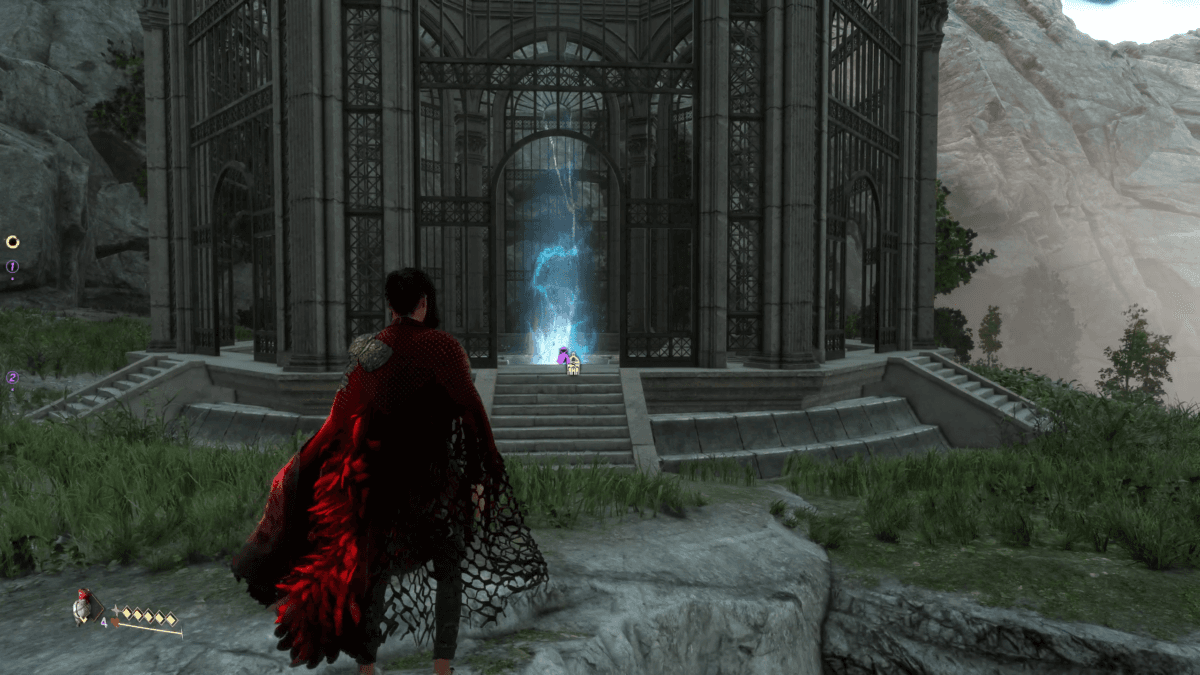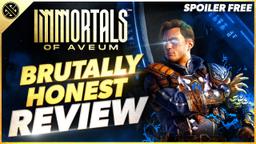Forspoken
Written by - Codiak
Updated: June 20, 2023
|
Posted: January 30, 2023

Thank you to our partners over at Square Enix for providing us with a launch-day key for PC. We were a bit surprised that PC keys weren’t given out in advance with the rest of the console keys, but this does lead into the first topic we want to touch on.
I’m sure by now you’ve seen countless posts about the game’s PC requirements. We expected them to be beefy for a high resolution and pumped up graphical playthrough, but nothing like what was published.
The spec sheet was revealed super close to the game’s release and to our knowledge, PC reviewers were given codes only on release day. Now to be clear, there’s nothing wrong with this. And when you can provide review keys for all your systems in a similar fashion, it’s a level playing field. But to gate keys to one platform, is a bit of a head scratcher. This whole set of circumstances screams PC game optimization issues and damage control.
SYSTEM REQUIREMENTS
So, let’s check out the PC requirements for a minimally viable experience. These are probably specs you have if you’ve built in the last 5 years, so it’s not an outrageous requirement, but keep in mind, this is the bare minimum and only gets us to 720p and 30 frames per second.

But if we go to the other end of the spectrum, you can pretty much bet this won’t apply to a majority of your player base. You may have these if you paid a premium and built your system in the last several months.
Now I may be cynical here, but this is just out of touch for an average player. But at the end of the day this will supposedly get you 4k and 60 fps.
For transparency, we’re fortunate enough to have systems that can accommodate most of the game’s requirements. The 20 hours we played were captured on a PC running a Ryzen 9 5900x, an NVidia GTX 3090, and 32GB of RAM. We juiced the settings to max, including 4k, and we saw on average 30-40 fps, which was still perfectly playable, and we didn’t encounter any major lag or graphical issues. That being said, this won’t be a lot of player’s experience on PC, and it’s unfortunate to see the development team lay out a set of requirements that automatically thins the player base right off the bat or at the very least, drastically diminishes a high-fidelity experience.
THE INITIAL EXPERIENCE
With the technical stuff out of the way, we can finally jump in and talk about the game. Forspoken puts us in the shoes of Frey Holland, a 21-year-old New Yorker in trouble with the law and just down on life in general. The game brings you into the fold through various opening cutscenes along with a few interactable moments in between to get you familiarized with controls, the HUD, and other gameplay details in a bite size experience. This is standard with game intros and it’s typically a great way to set up some backstory and context for the player. But there’s nothing special or revolutionary in any way about this starting experience.
Right after this intro is when things get super frustrating. Over the course of the next hour, you’re stuck in an awkward cutscene and gameplay loop that interrupts your play experience almost every 30 seconds. No sooner do you get moving after a long series of cutscenes, the game takes over again and explains more of the story or introduces a mechanic. This is just straight up padding. There’s no value add allowing me to control my character for 5 seconds only to take it away again and, in fact, I found this to be even more frustrating than if the team had just presented everything in one seamless cinematic.
There were several sequences that could have easily been dialog as your character was moving in the world, but the team for some reason decided to stop the gameplay and make you watch cutscene after cutscene. For the sake of this review, I started documenting the amount of time I was in cutscenes vs playing the game.
In my first 23 minutes, I recorded a whopping 3 minutes and 39 seconds of time I actually had control over my character. Outside of that, I was forced to sit through a ton of bloat that could have been introduced in a much more meaningful way. If you average it out I was interrupted by a cutscene or forced mechanic every 45 seconds. Talk about a bad first impression.
In my first 23 minutes, I recorded a whopping 3 minutes and 39 seconds of time I actually had control over my character.
I’d like to say the rest of the game was different, but I’m sad to report it wasn’t. If you simply follow the story, the majority of your playtime is in this restrictive and non-interactive state which is such a huge barrier to most players and super demotivating to push through. When you get your hands on a new game, you want to play it, not watch it.
Now to counter this, I can say the game absolutely has some great story moments that they do deliver well. But it’s as if those isolated moments were created by a completely different team. In those moments the pacing was great and gave me just the right amount of info I needed to understand what was going on without breaking the immersion, but it was a consistently inconsistent experience.
THE OPEN WORLD
Let’s jump in to arguably the biggest feature of the game, the open world. Like many games, the open world concept is heavily relied on to fill gaps between story moments and allow the player to explore to their heart’s content. Forspoken doesn’t change that formula, and falls into a classic open world pitfall, pad out the content and run up the game time.
The map and world team do a fantastic job here creating the land of Athia. The visuals in the world were excellent, offering several different biomes to explore and various terrains to test out your “magical parkour”. And more than enough points of interest and collectibles. You could spend tens of hours going through this map to visit every camp, collect every chest, and explore all there is to do. If you’re a true completionist, this is the part of the experience for you.

While exploring you’ll run across numerous activities, but the most arguably the most essential are the refuge buildings found throughout the map. These serve as a chance to rest and regain health and double as a quick travel location. In addition, they contain consumables to stock up on, a crafting station, and sometimes a logbook that displays new locations on the map, often being the next refuge site to visit.
A second fast travel point are belfrys towers. When activated they clear the fog of war and add points to the map in that particular area which you can observe from a bird’s eye view and choose where to go next.

We’re given a couple types of content loops in the form of labyrinths and objective time trials. Timetrials are scenarios and challenges that you’re tasked to complete within a time limit. Defend the villagers, kill the enemies, collect the things, you get the idea. These are challenging and grant appropriate rewards based on your completion percentage. Labyrinths on the other hand are essentially mini dungeons. You’ll venture into the unknown and brave the maze, face numerous enemies and attempt to find the secrets held within. Neither of these were revolutionary in their implementation, but they offer a change from navigating the open world none-the-less.
Scattered everywhere, and I mean literally everywhere, are chests. I think we all love discovering those secret chests in games, but here, there’s nothing secret; or to discover. You can throw a stone in any direction and hit one. The team even went as far to show you where they all are on the map once you reveal that area. The objective here doesn’t seem to task you with finding them, rather the challenge is getting to them. These are often placed on high earthen pillars, guarded by mobs, or located in a hard-to-reach areas, but sometimes are just out in the open with no challenge at all.
While I love the feeling of opening a chest, these are literally rubber-stamped assets placed everywhere, clearly for filler, and only offering basic crafting materials and sometimes a rare object. These are far from anything engaging and I would have loved to see something much more unique and fulfilling in its implementation.
Littered throughout the rest of the map are busy-work objectives to go clear an area of enemies, find a stat boosting monument, or scout to a given location, again more filler and not much reward. But speaking of rewards, the team decided to show you right on the map what the objective offers for completion be it a piece of gear, XP, or stat points.

Side quests or as the game dubs them, detours, are the last major piece to the world that I want to bring up. I’ll be honest, I only did a few and those that I did were not engaging at all. There was a lot of walking around, talking to NPCs, collect this or that resource, go to A-B-C destination, and defeat X-Y-Z enemy, but nothing that enhanced the story or enriched my experience.
All this to say, there’s a ton to do in this world, however, a lot of this seems rubber stamped, and clearly implemented to pad the game to extend your playtime. It’s that simple. I’d even go as far to say that once you’ve visited a small area, those same activities are simply copied to other areas with very slight variations. Even down to the enemies, which are just reskinned mobs that have the same move sets, just packed with more health, or do more damage. Does it look good? Absolutely, but once I understood the lack of uniqueness throughout, it really became just another chore to collect enough items to dump into my character’s progression. And that’s not something that kept me engaged for very long.
There’s a ton to do in this world, however, a lot of this seems rubber stamped, and clearly implemented to pad the game to extend your playtime.
GEAR AND CRAFTING
Alright let’s talk about the big draw to RPGs, gear and crafting. Well, there’s not much to talk about. We essentially have 3 main pieces of gear. Cloaks, necklaces, and nails. Now I’ll give it to the devs, I have never seen nails as a gear option and this was actually a really unique implementation and appropriate for the character and story.

You’ll obtain gear from quests, world objectives, and story completion. Each item has basic stats and up to 3 customizable enhancements slots and then each piece can be upgraded in level. Upgrades are done at crafting stations which are in every refuge you visit. Here you also have the option to craft potions and increase your medicine and material bags. Every upgrade or crafted material requires some sort of material that can be found while exploring the world. Each time you visit a new refuge building’s crafting station, you also unlock a few new traits as options to add to your gear.
Look, you all know I’m a huge fan of systems that impact gameplay, so I was super disappointed to discover everything here is just a stat dump. There don’t appear to be any gameplay altering options. You’re limited to boosts like “plus stat” modifiers and minor status effect alterations, but not much else. In this case you can simply just slot whatever gives you the biggest buff and while that’s fine, it’s incredibly boring and uninspiring. The sole purpose of the system is to build out a character to take on harder enemies and objectives. Overall, it doesn’t change the experience and, in my opinion, the whole gear system was a big generic miss.
COMBAT AND TRAVERSAL
Let’s shift gears and talk about my absolute favorite part of the game and what was arguably advertised the most, combat and the “magical parkour”. These mechanics and overall systems felt great. In fact, it’s obvious this is where most of the development time went. In comparison it made the rest of the game feel like a distant afterthought.
You gain your parkour abilities super early in the game. Allowing you to use them to explore and feel that sweet freedom of movement coming out of all those cutscenes. The team did an incredible job making you feel like you were flowing effortlessly through the environment. Every potential obstacle is used to enhance this system, even down to the enemies themselves, using them to vault around and reposition on a dime to get the biggest advantage in combat. I truly never felt like this system, or the environment was working against me. It just worked.
Your combat abilities are spread across 4 different trees of magic that you obtain as you complete parts of the story. These are simply called purple, red, blue, and green trees. I enjoyed the way we got to discover each part of the system and how these were opened up. While I won’t go in to spoilers, it was actually well paced and implemented in a way that made sense and didn’t feel forced.

Each tree dabbles in a field or element of magic that certain enemies are either vulnerable, neutral, or resistant to. Fortunately, you have the full flexibility to switch between the trees at will at any point, including in combat. This is a great way to make multiple spell kits available without overburdening the player to keep track of dozens of key binds. Simply swap to the tree you want and use your existing key binds and select the spell to rain down hell on your enemy.
Each tree feels unique, and sprinkles in your parkour abilities for added effect. For example, the charge ability rushes forward, staggers your enemy, and you vault backwards allowing you to reposition for your next attack or make a quick getaway.
So how does building out these trees feel? Well, I’m happy to report, it feels pretty dang good. I never felt forced to make a decision I didn’t want to. As you progress through the world and complete objectives, you accumulate mana points. These are your currency to unlock each skill that has an associated cost. Once unlocked most skills can be refunded, which is a great feature that allows you to spend points, try out the ability, and if it’s not something you enjoy, you can get that mana back to spend somewhere else. This is a great quality of life feature that respects your time and doesn’t punish you for a mistake.
Now enhancing skills is a little different. Remember the refuge buildings? Well, each contain a spell crafting station. Here is where you target specific abilities to hone and upgrade. I really liked this system. You get to target abilities you use and enjoy and ignore what you don’t. The system gives you objectives to complete and clearly informs you what the upgrade does. Once the objective is complete, you’ll receive a boost to that skill and its effect. This is a great way to expose you to using abilities in combo with one another and I really love the way the team lets you focus on something you want to enhance, not needlessly forcing you to slog your way through things to get to eventually get what you want.
The combat was great and flowed seamlessly with the movement of your character, and the spells actually felt impactful. And that’s a great nod to how well the team crafted these abilities and really spent time making the system feel cohesive and ultimately an extension of your playstyle.
The combat was great and flowed seamlessly with the movement of your character
I do have one critique, and that’s about the hidden spells within each tree. To open these up you must find founts throughout the world. The system is simple; search and interact. There is no gameplay once you find them and no further depth to unlocking it. You jump into the fount, and the ability is now yours. A super shallow method the team chose to implement here and again, just more padding.
While simple stat boosts aren’t really appealing to me, I don’t mind so much in this implementation. There is plenty of variety to change up slotted spells and I had a bunch of options to choose from. I’m not going to gush that the system did anything new but all in all, I really appreciate the focus the team took on this core function of the game. It was well implemented and, in the end, it was just fun to interact with.
A FEW MORE THINGS
Before the game launched, we saw plenty of critiques on the voice acting. I want to be very clear here. The voice acting is great. You can tell the actors were directed and they do an exceptional job at delivering their lines. The characters were convincing, and you could feel the emotion through their delivery. It’s the writing that has the issues. While the delivery of a line was great, the line itself often seemed out of place, forced, or just awkward. The main character has a lot of inner dialog that is made external, and this kind of writing just didn’t work well. There’s a reason internal thought should stay internal. There are plenty of games that convey a character’s inner thoughts in a way that still drives the story forward, but Forspoken is not one of those games.
I also think it’s worth mentioning, we didn’t encounter any real bugs or broken systems during our playthrough. The systems advertised were all there and seemed complete. This was refreshing as many of today’s gaming experiences are littered with half-baked products that got shipped out way earlier than they should have. Obviously, this was a big concern for us because of the last-minute PC key and computer spec recommendation, but it didn’t end up being a big factor.
Now one final and major criticism I have is again around the pacing of some important story moments. This frustration just kept coming back like a bad cold. As we touched on in the beginning, several major story sections were just unnecessarily padded having us jumping from cutscene to cutscene, giving you control for a just few seconds only to engage in the next cutscene. A simple enemy fight is thrown in occasionally as a clear indication the team thought they needed to add something in to break this up, but that should have been an obvious flag to rework the delivery as a whole. Nothing here was meaningful, and as these delivery methods dragged on, I became less and less interested in the story they were telling, because it wasn’t fun or engaging, quite the opposite. This was a massive miss for the game, and really sealed the deal on our overall impressions.
CONCLUSION
At the end of the day, whenever we play any game we want our playtime to be meaningful, and ultimately enjoyable. Forspoken delivers some things well. I had plenty of fun as I ran across the world for example, but the longer I played, the more I realized I’ve seen all this multiple times over and had no real desire to see more of the same.
The story may have been decent, but I was forcefully oversaturated with cutscenes that bloated my experience and ultimately really killed my desire to continue playing. Upon finishing the game, I was glad it was over and coming in at a whopping AAA price of $70 and with all the blatant padding and rubber stamping throughout, we can only conclude that Forpsoken is not worth your time.






